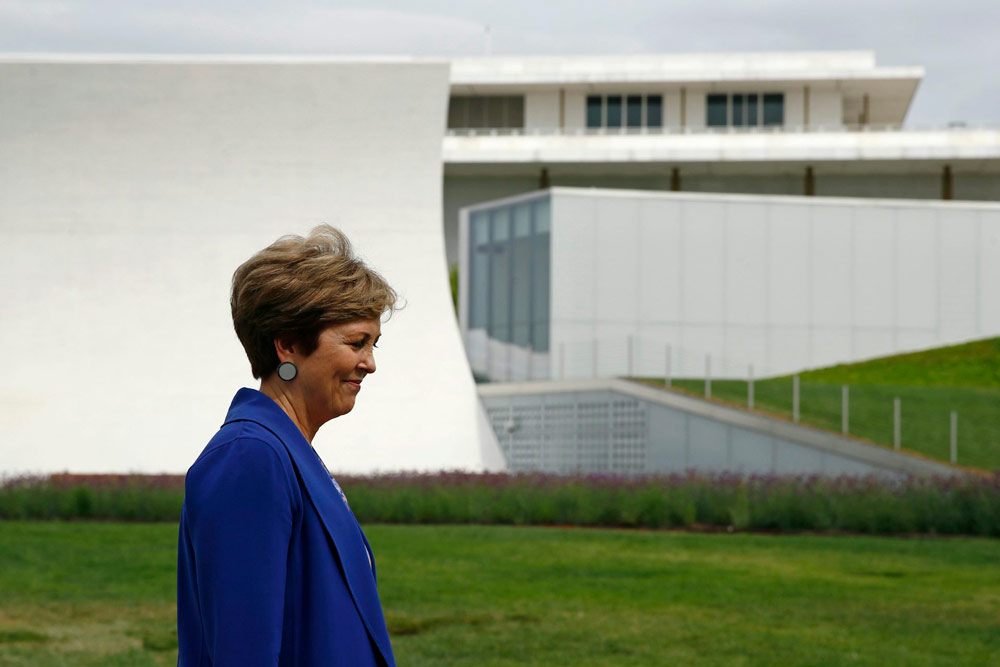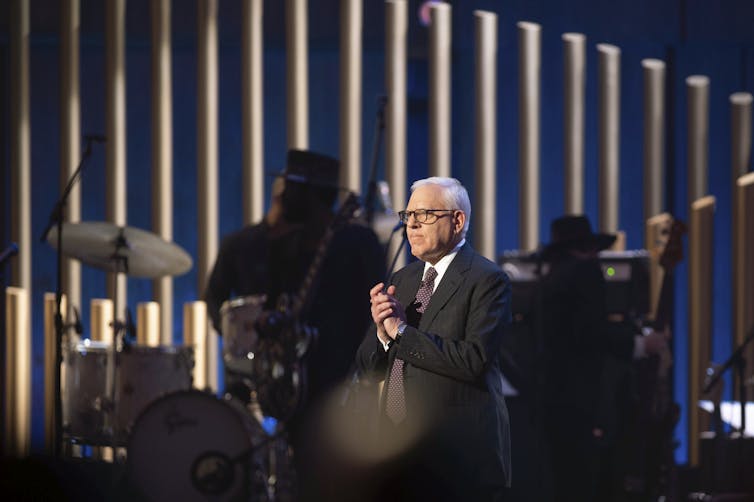
By E. Andrew Taylor
President Donald Trump dismissed half the appointed trustees of the John F. Kennedy Center for the Performing Arts’ board on Feb. 12, 2025. The remaining board members, most of whom he had recently appointed, then voted to make Trump the center’s chair. The board also fired Deborah Rutter, who had served as the center’s president since 2014 and already planned to step down seven months later.
The board replaced Rutter with Richard Grenell, who served in the first Trump administration.
The Conversation U.S. asked E. Andrew Taylor, an arts management scholar, to explain how the Kennedy Center operates and sum up the significance of Trump’s unprecedented interference with its operations.
Why is the government involved in the Kennedy Center?
The Kennedy Center, a unique cultural enterprise located along the Potomac River in Washington, has a complex ownership and operating structure. The campus includes three large performance halls, two midsize theaters and many smaller venues and public spaces that host musical, theatrical and dance performances, lectures, exhibits and other special events. In form and function, it looks a lot like other major metropolitan performing arts centers, such as New York City’s Lincoln Center. But its structure is different.
The Kennedy Center is part of the federal government. Officially, it’s a bureau under the Smithsonian Institution.
It was originally conceived during the Eisenhower administration and later championed by President John F. Kennedy. It was named after JFK following his assassination.
The center opened in 1971, with a world premiere of composer Leonard Bernstein’s “Mass.” President Richard M. Nixon did not attend after the FBI warned him of possible anti-war messages encoded in the Latin text that might be designed to embarrass him.
The center’s current mission statement captures its purpose and goals:
“As the nation’s cultural center, and a living memorial to President John F. Kennedy, we are a leader for the arts across America and around the world, reaching and connecting with artists, inspiring and educating communities. We welcome all to create, experience, learn about, and engage with the arts.”
Why does the Kennedy Center have a nonprofit board?
From the start, the Kennedy Center was planned as a public-private effort. Government funding covers the maintenance, upkeep, security and restoration of the building and grounds.
Private funds, largely derived from ticket sales, individual donors, foundations and corporations, cover the performances, productions and other programs.
Those private funds cover more than three-quarters of the Kennedy Center’s budget. Its 2023 annual report explained that its US$286 million in revenue included $152 million from ticket sales, services and fees, $85 million from donations and $45 million from the federal government, with the rest derived from income from its endowment and other sources.
In accordance with this public-private mix of revenue, the center’s governance has always been a hybrid, with the structure of a nonprofit board but with political appointees.
The Kennedy Center’s board is authorized by its legislation to solicit and accept private donations, enter into contracts, maintain its halls and grounds, and appoint and oversee professional leadership. For the most part, it has the same responsibilities as any nonprofit board.
There’s a big exception, however.
While most nonprofit boards recruit, elect and develop their own membership, the Kennedy Center board consists of government appointees. About two dozen trustees serve by virtue of their government office, such as the librarian of Congress, the secretary of state, the mayor of Washington and the speaker and the minority leader of the U.S. House of Representatives.
Up to 36 more are appointed by the president, each serving staggered six-year terms so that they don’t all expire at the same time.
Is the board supposed to be nonpartisan?
The six-year terms reflect a goal of establishing a largely nonpartisan governing board, since presidents usually appoint board members aligned with their own party. Until now, that balance has been the norm. But that outcome wasn’t mandated when Congress passed legislation establishing the Kennedy Center.
Having a politically balanced board has historically helped the Kennedy Center raise money and attract world-class artists. For example, the 2025 season, as of mid-February, will or has included Alvin Ailey American Dance Theater, jazz pianist Kenny Barron, soprano Renée Fleming, author David Sedaris, comedian Sarah Silverman and touring productions of “Parade” and “Les Misérables.”
Its in-house productions are often classic works, such as “La Bohème” and Beethoven’s symphonies. Many of the center’s theatrical productions have gone on to Broadway and national tours, including “42nd Street,” “Noises Off” and revivals of “The King and I,” “Annie” and “Spamalot.”
I’m concerned that many longtime or potential future donors may not want to contribute to a cause that has suddenly become subject to partisan leadership.
Many artists and creative partners have already begun to sever their ties to the Kennedy Center or cancel upcoming shows at its venues out of an aversion to the board’s dramatic political turn. Some performances and tours tied to the center have been called off for other reasons that haven’t yet been made public.
Members of the public may balk at attending events at a politically charged venue, especially with so many other performing arts options in and around Washington, reducing ticket sales.
What does the Kennedy Center chair do?
Board chairs are in charge of the governing board, expending considerable energy, attention, effort, political muscle and often personal wealth to ensure that the organization can thrive.
The Kennedy Center’s prior chairs have not been figureheads. Rather, they have been actively engaged in fundraising, strategic planning and public advocacy. The legislation that chartered the center requires that its chair and secretary “shall be well qualified by experience and training to perform the duties of their respective offices.”
Trump has admitted that he’s never seen a show at the Kennedy Center. He has no prior relevant arts board leadership experience. And he is constrained from serving on a nonprofit board in the state of New York after admitting to the misuse of charitable funds by the now-dissolved Donald J. Trump Foundation.
David Rubenstein, the board chair ousted by this upheaval, has given the Kennedy Center at least US$111 million, making him the center’s biggest donor ever. The philanthropist spearheaded fundraising for its first major expansion, securing significant support from private corporations and foundations.

AP Photo/Kevin Wolf
Has anything like this happened before?
No U.S. president has served as a member of the Kennedy Center board before, let alone its chair.
Presidents do often appoint their friends and allies to government boards and commissions, and often remove appointees of previous administrations. President Joe Biden, for example, removed Sean Spicer – a former Trump press secretary and White House communications director – from the Naval Academy advisory board.
But that board is leading a strictly governmental body, not a public-private hybrid so dependent on private funding. And the speed and scale of this purge are unprecedented.
What are the potential consequences?
All big, multi-venue metropolitan performing arts centers are extraordinarily complex and difficult to manage.
The John F. Kennedy Center for the Performing Arts is particularly so. It hosts approximately 2,200 performances that draw more than 2 million visitors each year, with an in-house symphony and opera company. It produces the Kennedy Center Honors, which celebrate exceptional American artists with an annual gala, performance and television broadcast, and the Mark Twain Prize, which honors one accomplished American comedic actor, author or performer each year.
It’s also a national hub for arts education that serves 2.1 million students and teachers across all 50 states, doubling as an open campus: It offers daily free performances of everything from classical chamber music and ballet to jazz and rock bands.
Even under the best possible conditions, this is a lot to handle.
Successful arts nonprofits benefit from a governing board whose members have expertise in the arts, business and philanthropy, are loyal to the mission above themselves, and rigorously follow the law. Beyond those basics, ideal conditions also include having enthusiastic audiences, passionate donors, eager and exceptional artistic collaborators, and creative and administrative teams that are supported and empowered to do their difficult work.
With Trump’s takeover of the Kennedy Center board, this national cultural center has now, essentially, turned into a branch of the White House. In my view, that’s a disturbing turn of events in a nation that celebrates free and creative expression. It’s also disruptive to a complex, mission-driven enterprise that demands care, loyalty and obedience from its governing board.
![]()
E. Andrew Taylor is Associate Professor and Director of Arts Management at American University.




























BillC says
Dr. No > Goldfinger > Elon Musk > Trumpfinger
Thomas Hutson says
Kennedy Center
OMG, king Trump a/k/a President Trump has finally found something to attach his King name to , other than Casinos . Think about this renaming the Kennedy Center to: King Trump pseudo King Musk , Center for the Performing Arts. They’re both passionate supporters of the performing arts .
Laurel says
Oooooh, the Trump Center! Now we can watch a whole bunch of Kid Rock concerts, World Wrestling Entertainment, Trump dancing to “WMCA,” Fox and Friends in depth discussions, MTG and Kristi Noem shoot off events, far, far right speeches by Steven Miller, Elon Musk explain why we don’t need “jobs, jobs, jobs,” and Melania Trump explain why her nude photos are really “art.”
Can’t wait!
Trump’ll fix it. He’s all class.
john says
Our election was between Biden and Trump, little did they know Trump was going to get paid off by Musk and now in turn he is running our country. He is a billionaire that could careless about the American people, he is just making sure his space travel violations are eliminated and that he can control his space program against other space companies. He now has access to everyone’s bank accounts, birthdays, social security numbers etc etc.
The Republican Boys Club in Washington are too coward to stand up and put a stop to this madness.
Robjr says
Orange Aid’s first star studded headline performance will feature none other than…….(drum roll) Kid Rock.
glenn says
Soon to be renamed the Ivanka center of cosmetics.
Skibum says
One can easily find, if one has a mind to, the near-nude photo shoots of Melania and videos of drumph rambling on about the size of Arnold Palmer’s wiener that he seems to be so fixated on. These two have so little class, no sense of culture, and an appalling lack of appreciation for the performing arts that it is enough to make a person vomit at the thought of him in charge of, and making artistic decisions for the Kennedy Center! I can imagine some wrinkled old mama wearing her maga ballcap standing on the stage with drumph, attempting to give him basic dance lessons so he doesn’t look so unhinged next time he calls forth the maga mob for a rally and tries to wave his arms around to the tune of YMCA. I just hope Melania has bought a new coat by now, because we already know she really doesn’t care. Pathetic.